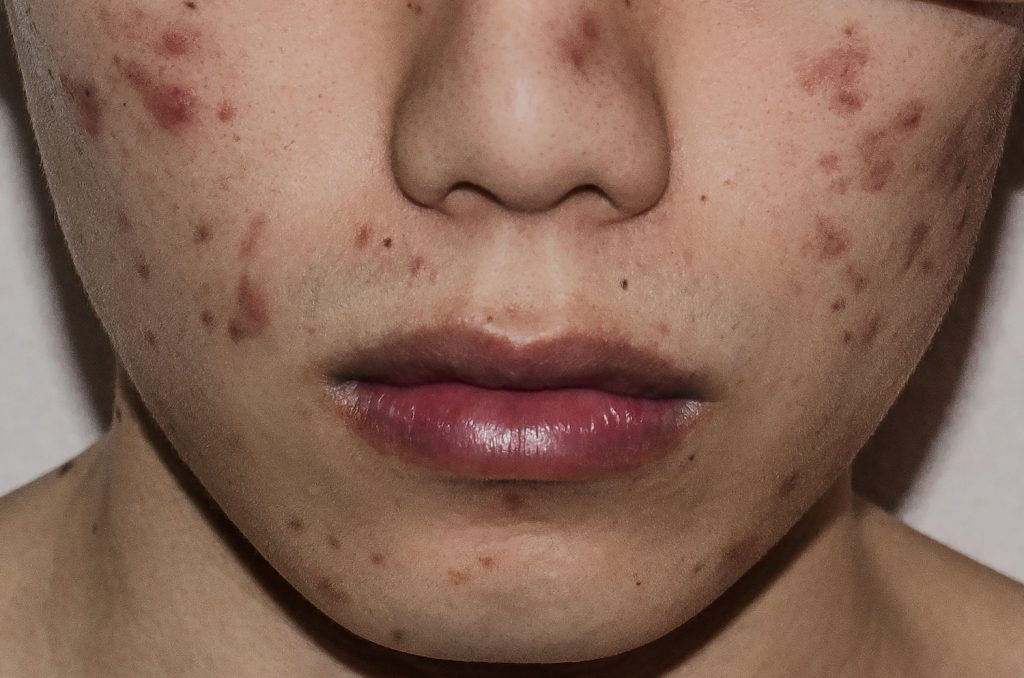
Lymecycline and doxycycline are antibiotics used to treat skin conditions like acne and eczema. In this post, we’ll compare lymecycline vs doxycycline to help you understand its uses, benefits, and side effects. This comparison aims to give you an idea of what each medication offers so you can start your journey to clearer skin.
| Aspect | Lymecycline | Doxycycline |
| Drug Class | Tetracycline antibiotic | Tetracycline antibiotic |
| Active Ingredient | lymecycline | doxycycline |
| Used to Treat | Moderate-to-severe acne vulgaris Widespread acne Rosacea | Moderate-to-severe acne vulgaris |
| Drug Form | Capsule | Tablet, capsule, liquid |
| Dosage | One capsule a day | One capsule a day |
| Common Side Effects | Nausea, headache, stomach upset | Nausea, stomach upset, photosensitivity |
| Who is the medication suitable for? | Children and adults over 12 | Children and adults over 12 |
| Patient Information Leaflet | Lymecycline Patient Information Leaflet | Doxycycline Patient Information Leaflet |
Lymecycline, a tetracycline-class antibiotic, is a go-to medication for treating acne. It targets the bacteria that aggravate acne symptoms, reducing inflammation and fewer breakouts. Its effectiveness isn’t just limited to eliminating existing acne; lymecycline also works to prevent future outbreaks by keeping the bacteria under control.
This medication is beneficial for those who haven’t found success with topical treatments like benzoyl peroxide. It’s a systemic approach, meaning it works throughout the body and can be taken for skin conditions of the face, shoulders and back. However, you may need to wait several weeks or even months to see significant changes in your skin condition.
When it comes to treating acne with lymecycline, the approach is quite targeted. Moderate to severe acne often results from a combination of bacteria, oil production, and skin cell turnover. Lymecycline attacks the bacteria known as Propionibacterium acnes, the leading cause of acne development.
This bacteria contributes to the inflammation and infection of acne. By reducing the bacteria, lymecycline effectively lessens inflammation and infection. This leads to a decrease in both the severity and frequency of acne breakouts. Its action is not just on the surface; lymecycline works from within to help clear the skin.
Another aspect of lymecycline’s action against acne is its ability to reduce the production of fatty acids in the skin. These fatty acids can contribute to clogged pores, which exacerbate acne. By controlling these fatty acids, lymecycline helps keep pores clear, further aiding acne management.
It’s important to note that while lymecycline is effective, it’s often part of a broader acne treatment plan. This may include topical treatments, like Azelaic Acid or Differin, or lifestyle changes.
Eczema, characterised by itchy, inflamed skin, can sometimes become complicated due to bacterial infections. While not a primary treatment for eczema, lymecycline can effectively manage secondary bacterial infections that often accompany eczema flare-ups.
These secondary infections can exacerbate eczema symptoms, making the skin more inflamed, itchy, and uncomfortable. By targeting and reducing the bacteria on the skin, lymecycline helps alleviate these additional complications, relieving eczema sufferers.
Lymecycline is typically prescribed for eczema when there’s a clear sign of bacterial infection. It’s not used for managing eczema alone but as part of a treatment plan that may include other medications, like corticosteroids or moisturisers, to directly address eczema.
Most side effects of lymecycline are mild or temporary but can cause side effects in some individuals:
To see a full list of side effects, click here.
Doxycycline is also a type of tetracycline antibiotic. It is widely used to treat various bacterial infections, including those that cause acne. Doxycycline works by stopping the growth of bacteria, thereby helping to clear up infections. Its use in acne treatment is due to its anti-inflammatory properties and effectiveness in reducing acne-associated bacteria. Doxycycline is often prescribed when other treatments have not worked.
Besides acne, doxycycline treats other conditions too. It’s used for respiratory tract infections, urinary tract infections, and certain types of sexually transmitted infections.
Doxycycline targets the bacteria that contribute to the development of acne, much like lymecycline. However, its anti-inflammatory properties set it apart, helping to reduce the redness and swelling associated with acne breakouts.
This antibiotic works by inhibiting the production of proteins the bacteria need to grow. This disruption in the bacterial life cycle helps to clear up existing acne and prevents new breakouts.
Doxycycline is particularly effective against inflammatory acne, which includes red, swollen spots. Its ability to penetrate deep into the skin makes it an effective treatment for more severe cases of acne that don’t respond well to topical treatments.
While doxycycline is a powerful tool against acne, it’s usually part of a broader treatment plan. It might be combined with topical treatments, such as creams or gels.
Doxycycline’s use in eczema primarily focuses on treating secondary infections that can occur with this skin condition. Eczema, characterised by dry, itchy, and inflamed skin, can sometimes lead to breaks in the skin. These breaks can become gateways for bacteria, resulting in infections that worsen eczema symptoms.
Doxycycline helps by reducing the bacteria that cause these infections, which can alleviate the additional discomfort caused by the infection, such as increased redness, swelling, and pus formation.
Doxycycline is not a direct treatment for eczema but is used when an infection complicates the condition. Your GP or pharmacist will determine if a bacterial infection is present and whether doxycycline is an appropriate treatment option.
Understanding the side effects of doxycycline is important as these can vary from person to person:
For a full list of side effects, click here.
A study comparing Lymecycline with Minocycline, another antibiotic, provided valuable insights. This study is relevant because it reflects on the effectiveness of tetracycline-class antibiotics, to which both lymecycline and doxycycline belong. The findings showed no significant difference in effectiveness between Lymecycline and Minocycline in reducing various types of acne lesions. Both treatments were well tolerated, with slightly fewer adverse gastrointestinal and dermatological effects with lymecycline.
In a broader analysis of pharmacological treatments for acne, an analysis of single drugs and antibiotics to treat a particular disorder or disease, like Doxycycline and Lymecycline, were generally less effective than combination therapies. However, among the antibiotic options, oral doxycycline and oral lymecycline ranked among the top in reducing acne lesions.
Another study conducted by the Indian Association of Acne compared topical 2.5% benzoyl peroxide gel with oral doxycycline versus topical 2.5% benzoyl peroxide gel with oral lymecycline for treatment of acne vulgaris and found that ‘lymecycline is superior to doxycycline, with much statistical significance among moderate-to-severe acne”. “There was earlier reduction in lesions and the duration of therapy needed was also less than that needed for doxycycline.”
These studies suggest that both Lymecycline and Doxycycline are effective for treating acne. Their performance is comparable, with lymecycline being slightly more efficient, and they both stand out among antibiotic treatments. The choice between the two may come down to individual considerations like side effects and personal response to the medication.
As Doxycycline and Lymecycline are part of the same antibiotic class, they have similar prescription criteria:
Lymecycline is especially effective against inflammatory types and is typically administered conveniently once daily. In contrast, doxycycline has a dosing schedule that varies and may require multiple doses per day.
Lymecycline often involves a more extended treatment duration, sometimes spanning several months, and is generally safe for long-term use under supervision. Doxycycline, safe for extended use as well, demands more careful monitoring due to its broader range of effects and varied treatment length, often shorter for acne than lymecycline.
Lymecycline and doxycycline, while distinct in certain aspects, share notable similarities. Both belong to the tetracycline class of antibiotics and are commonly used in acne treatment, helping to reduce inflammation and acne lesions due to their antibacterial properties.
Both medications share common side effects, such as nausea and stomach upset, largely due to their similar chemical structures. Additionally, they can interact with other medications, including antacids and blood thinners. It is essential to note that overuse or misuse of either drug can lead to antibiotic resistance, so they should only be taken as prescribed.
If you’re considering Lymecycline or Doxycycline for your acne treatment, at Click2Pharmacy, our online acne treatment clinic is designed to make your journey to clearer skin as smooth as possible. Getting a prescription is straightforward. Just visit our website and fill out the consultation form. From there, our team will reach out for personalised advice and support. We ensure that all consultations are handled with the utmost care and confidentiality.
Choose Click2Pharmacy for a trusted, convenient, and supportive path to managing acne. Contact us today to start your treatment with Lymecycline or Doxycycline and take the first step towards clearer skin.







